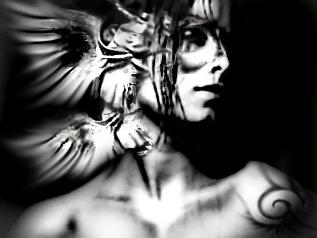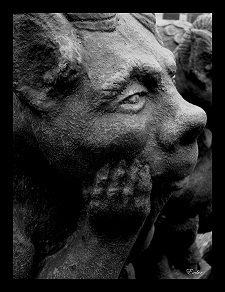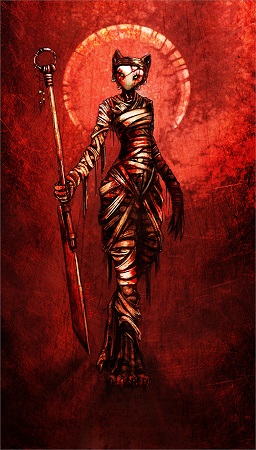Old Gods (Armidale)
The Meeting Place has a number of statues of old gods craved into the large rocks that inhabit the place. Only Nodens, Bast, and the nameless Sunken God have statues.
- Hypnos
The statue to Hypnos is not visible in the waking world, but some supernatural powers can reveal the site where it once stood
The God Hypnos(Sleep) according to the ancient Greeks was the twin brother of Thanatos(Death) the son of the Goddess Nychta(night) and Herebos.They imagined him as young, handsome with wings on his shoulders making tired people fall asleep by sprinkling them with a branch wet with oblivion or by watering them with a horn full of hypnotic essences. Hypnos was really powerful.He was able to make all the people fall asleep and the gods too. He once made Zeus the king of the gods to fall asleep after urges by Hera who wanted to intervene in the Trojan war.According to the story Hera visited the Greek island of Lemnos where Hypnos dwelled and pronounced him Archon(lord) of Gods and mortals in order to persuade him.Hypnos was doubtful about dealing with Zeus but finally he was persuaded by an offering to marry one of the three Charities(Graces), particularly Pasithei with whom he fell in love. Pasithei symbolized relaxation and rest, that's why she was desired by Hypnos.The plan went well for Hera. While she was seducing Zeus, Hypnos appeared transformed as a bird and hypnotized him.
- Nodens
Nodens - later known in Wales as Nudd or Lludd Llaw Ereint (the Silver-Handed) and in Ireland as Nuadu - was the Celtic God of Healing, and the son of Belenos, the Sun God, and Anu, his wife. He had a large shrine at Lydney (Lludd's Island) in Gloucestershire, where the devoted made offerings of small bronze representations of their diseased limbs. He was sometimes identified with the protective Mars or the regenerative Silvanus and his companion and symbol was the dog: a deerhound whose lick could cure the afflicted. An old story explains his connection with amputees. At one time, Nodens was the leader of the gods, but he was wounded in battle and lost his hand. Gofannon, the divine-smith, made him a new one out of Silver - hence his Welsh epithet - though he was still forced to abdicate in favour of his nephew, Lleu Llaw Gyffes (the Skilful-Handed). Later, Nodens was troubled by a constant scream that was heard the eve of every Beltane. He travelled to Gaul, where his brother, Llefelys, was particularly worshipped, to ask his advice. He explained that the cry was made by two fighting dragons. Nodens managed to capture the creatures and imprisoned them deep below Dinas Emrys in Gwynedd. Nodens may have been particularly worshipped in London which, as 'Lludd's town' was said to have been named after him. He is equated with the Roman gods Mars, Mercury, Neptune and Silvanus.
- Bast
The Egyptian cat goddess Bast had numerous areas of influence that developed over time. In the early days she was the fierce lion headed Goddess of the lower Nile who protected the Pharaoh and the sun God Ra. This is why she has the title of Goddess of protection. In this role she became Goddess of the rising sun and holder of the Utchat, the all seeing eye of Horus. Statues of this Goddess would be placed in households to protect them from thieves. In the Book of the Dead she is mentioned as destroying the bodies of the deceased, with the royal flame, if they failed the judgement hall of Maat. Later she was depicted with the head of a domestic cat, representing her more nurturing aspects. Woman of the time would buy amulets of this Goddess illustrated with different numbers of kittens, representing the number of children they wished to have. The links to fertility and childbirth were further strengthened by the Greeks. They likened this Goddess to Artemis and she also became associated with the moon and children. As a cat Goddess she also protected houses from rats and snakes and so ensured the health of the occupants. The Goddess was linked to the music and dance due to the special rattle that she carried known as the Sistrum. The rattles were used to celebrate her festivals. She was connected with perfumes as she shares a hieroglyph with that which represented the bas jar. These were ceramic vessels used to hold expensive perfumes. Her son was also linked to perfumery. A Patron Goddess of fire fighters due to the Egyptian belief that if a cat ran through a burning household she would draw the flames out behind her. Her cult was centered in Bubastis, when her temple was excavated they found the mummified remains of over 300 000 cats. She was worshipped throughout the lower Nile. She was also known by several different names including Bastet, Basthet, Ubasti and Pasht. The name Pasht is the root of our word passion, linking this Goddess to physical pleasure.
- The Sunken God
The ruined statue of a nameless chthonic being was carved into the rock at the meeting place. At some point in 2015, the statue crumbled, leaving nothing but shards of rubble behind. The current rumour is that once the sun sets, before the final light of day departs, you can see a primeval cat shadow in your peripheral vision. Did is just move or was it your imagination? Is it even there at all?


